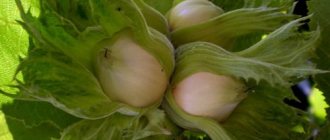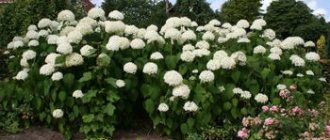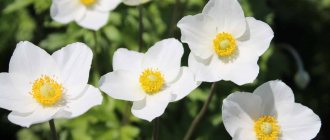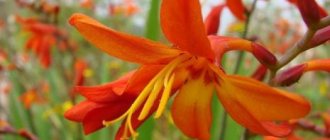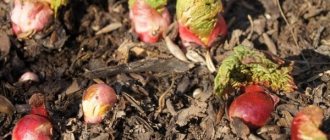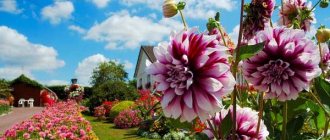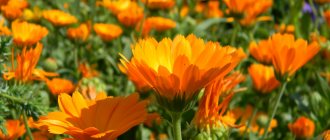Common hazel (Córylus avellána) is a species of woody deciduous trees and shrubs belonging to the birch family. There are other names for this plant, namely Hazelnut, Hazelnut and Hazel. Common hazel grows as undergrowth in coniferous and broad-leaved forests, in mixed forests and, often, on their edges. Hazel is a tree or shrub, let’s figure it out and get the answer.
Hazel photo of tree and leaves
Features of hazel
Corylus avellana, as a species, combines:
- trees whose maximum height does not exceed 20 meters
- shrubs reaching a height of no more than 10 meters
What is hazel: The dense spherical or egg-shaped crown of such plants is topped with a pyramidal top. Hazel leaves are large in size, they have a round or wide oval shape, and there are serrations along the edges.
Corylus avellana blooms in spring. The flowers differ in:
- male (staminate). The stamens are located in earrings, of which up to 5 pieces can bloom from one bud. The average length of earrings is 10 cm;
- female (pistillate). The pistils and perianths of the buds are underdeveloped. A fluff of reddish stigmas emerges from them. It indicates that future flowers are hidden there. Pollination is carried out by insects and wind.
It will be possible to harvest hazelnuts when the plant reaches its eighth year of life. The hazel fruit, which has a yellow-brown tint, is located in a helmet-shaped shell. The fact of their full ripening is evidenced by the fact that the shell has acquired a brown color, as well as the dry brown cover with a silvery tint of the inner kernel of the nuts. This occurs at the end of summer - in August.
Hazelnut photo
According to the description, the trunk of common hazel is characterized by flexibility, almost even, and quite long. Its bark is gray with a brownish tint and has a smooth, but rough surface. There is one peculiarity regarding the root system. Despite the fact that it is powerful, tree hazel cannot obtain moisture from the deep layers of the soil. The reason is that the main part of the root system is located close to the surface of the earth.
What is hazel can be seen in the photo
Varieties and types
The genus Leshchina has 17 species. The main ones are the following:
- Common hazel (Corylus avellana) - grown in Karelia, Crimea, throughout the southwest of Russia, Siberia, Perm Territory, Belarus, Ukraine. Lives up to 90 years.
- Pontian hazel (Corylus avellana Pontica) - grown in Abkhazia, is considered by many philologists as a botanical variety of common hazel, and some consider it a separate species. Includes many cultivated varieties that, when crossed, produce hybrids called green.
- Large hazel (Corylus maxima) - also called Lombard nut, comes from many old, cultivated varieties, which, as a result of crossing, produced hybrids called Lombard.
- Georgian hazelnut (Corylus iberica) - common in the North Caucasus, Abkhazia, and Dagestan.
There are many types of hazelnuts, which in our country are not as popular as those mentioned above:
- Manchurian hazel (Corylus mandshurica);
- hazel (Corylus heterophylla) - found in the Amur region;
- Turkish hazel (Corylus colurna) – this type of hazelnut is found in the North Caucasus and is included in the Red Book of the USSR.
Cultivated varieties of hazelnuts include common hazel, Pontic hazel and large hazel. In our country, many varieties of hazel are grown with different morphological characteristics, growing season, fruiting time or different fertility.
Popular varieties of hazelnuts grown in Russia, Ukraine, Belarus: Adygeisky 1, Akademik Yablokov, Anakliuri, Barcelona, Bolgradskaya Novinka, Bomba, Borovskoy, Warsaw Red, Grandiose, Gustav, Davydovsky, Dar Pavlenko, Long Landsbergsky, Dolinsky, Druzhba, Evgenia, Ekaterina, Ivanteevsky red, Caucasus, Catalan, Kerasund, Kirovograd, Cosford, Crimean, Kuban, Kudryavchik, Resort, Lombard white, Lviv, Masha, Moscow early, Moscow ruby, Nakhodka, Olympic, Memory of Yablokov, Firstborn, Perestroika, Pioneer 66, Victory 74, Excellent -1.
In gardens you can grow interesting, decorative varieties of hazel, which can vary in size, leaf color, vigor, fruit size, or resistance to low temperatures, diseases, and pests.
It is worth considering decorative varieties of common hazelnuts, such as:
- Aurea - hazelnut with golden yellow leaves and shoots;
- Pendula hazel is a hazelnut with drooping shoots.
Planting hazel in the garden
Obtaining a generous harvest involves developing and growing a scheme for placing hazelnut seedlings at the preliminary stage. It should be taken into account that when several trees are planted side by side in garden conditions, cross-pollination occurs naturally. Where do the hazel trees grow on the property and where do the hazelnuts grow? It is recommended to plant hazelnuts and hazelnuts along the boundaries of the land plot.
What time to plant
Planting Corylus avellana seedlings is allowed both in spring and autumn. But experienced gardeners advise doing this in the fall, when the soil has not yet cooled down - somewhere in early October.
Planting hazel in autumn
For planting it is necessary to select the following hazel seedlings:
- having a well-developed root system;
- on which at least 3-4 strong shoots grow. The diameter of each should be at least one to one and a half centimeters;
- There should be no leaves on the seedlings.
When several hazelnut and hazelnut bushes are planted, their distance in a row should be about 4 - 5 meters, when the row spacing is about 6 meters.
The pits are prepared a month before the planned planting date. During this period of time, the soil will not only settle, but will also have time to become sufficiently compacted. If the soil in the plot is poor, then the diameter of the holes and their depth should exceed 80 centimeters. When planting hazelnuts and hazelnuts in an area with fertile soil, the holes can be 50 centimeters deep and the same in diameter.
Before planting seedlings in the fall, you need to prepare a fertile mixture and fill the holes with it. The ingredients and consistency of the mixture are as follows:
- topsoil;
- rotted manure – 15 kg;
- 200 grams of superphosphate. If such an ingredient is not available, you can add 2 cups of completely burnt wood ash instead.
Hazel leaves in autumn photo.
This point is very important: when planting common hazel in natural conditions, its root system must be immersed for some time in a mash, the components of which are clay and manure.
A Corylus avellana seedling is placed on a small hill previously created in the center of the hole. Here a certain requirement must be met. It is formulated as follows: a hazel tree seedling, after the embedding is completed, should be positioned so that the neck of the root is about 5 centimeters above the ground level. Having filled the hole and compacted the soil, the gardener needs to drive a peg nearby and tie it up the seedling itself goes to it.
Then the newly planted hazel tree should be watered with three to five buckets of water. After letting it soak in, you will need to mulch the tree trunk circle with a layer of a mixture that includes dry peat, plant humus and sawdust. The thickness of this layer is within 3...5 centimeters.
How to plant hazel trees in spring
The procedure for planting a plant in the spring is the same. But experienced gardeners recommend digging holes for hazel seedlings the previous fall. This way, the soil in them will be saturated with sufficient moisture over the winter and will naturally become denser. In addition, the following conditions must be met:
- in one season, at least 3 hazel and hazel bushes are planted on a personal plot. Then pollination is guaranteed;
- It is recommended to plant different varieties;
- During the first time after planting, it is necessary to prevent direct spring sunlight from hitting the plant. This is achieved by shading it.
Hazel care
The process of caring for common hazel cannot be called labor-intensive. Hazelnut cultivation and care from proper planting. Sowing peas and oats, wolf bean (lupine) or synapis in the tree trunk will help reduce hassle. After mowing, the gardener can use them to mulch the soil.
The soil under the Corylus avellana plant can be kept weed-free and, at the same time, loose (so-called black fallow). The depth of loosening is within 4-7 centimeters. The gardener also needs to be prepared for a constant fight against root growth. There is no point in postponing such an event “for later”, since care will be easier and you can cope with newly born, weak offspring.
How to water
You need to start watering a hazel bush or walnut tree a week after these plants were planted. An insufficient amount of moisture will have a bad effect on the formation of flower buds, as well as on the subsequent ripening of hazelnut fruits. During the growing season, you need to water the soil under the hazel about 5-6 times. Water consumption for 1 adult bush should be from 6 to 8 buckets.
The frequency of watering hazelnuts is monthly. Moreover, during such a time interval it is enough to do this only once. Water should be poured into the tree trunk circle in equal portions, making sure that it is absorbed into the soil and does not form a puddle. It is advisable to loosen the soil there, either on the day when it rained or was watered, or on the next day.
Fertilizer
In the spring season, hazel is fed with phosphorus and potassium supplements. The frequency of this activity is once every two to three years. Under the hazelnut and hazelnut bush:
- superphosphate-50 grams;
- potassium salt - ranging from 20 to 30 grams;
- manure - about 3-4 kilograms
With the arrival of spring, hazel will require nitrogen fertilizers. So, having noticed that the buds are swollen, the gardener should add about 20-30 grams of carbonic acid diamide - urea - or ammonium nitrate to the soil around the tree trunk.
A shrub or hazelnut tree should be fertilized in the summer in order to simultaneously ripen the fruits. At the beginning of July, the same nitrogen fertilizing is applied. The situation is different with young plants. They need to be fertilized with organic substances - rotted manure or mature compost. For 1 Corylus avellana bush, it will be enough to apply 10 kilograms once for two to three years.
How to care for hazel when it blooms
Hazelnuts and hazelnuts begin to bloom when the air temperature reaches +12°C, that is, in mid-spring. This indicates that the plant is developing correctly.
The catkins bloom before the first foliage appears on the hazel bush or tree. Over the course of a day in dry atmospheric air, they often grow by 3 cm. After reaching a length of ten centimeters, the earrings, becoming loose, begin to scatter pollen grains. The pollination process lasts approximately 12 days. The female flowers receive pollen both from their plant and from flowers on the branches of hazel growing nearby. Taking into account this phenomenon, experienced gardeners recommend planting more than one tree or hazel shrub nearby. During flowering, the plant does not require special care.
Description of hazel
The domestic hazel is a representative of the Birch family and differs from wild varieties of trees growing in the forest in its significant yield and large fruits.
Did you know? In ancient times, hazel branches were used by shamans to find buried treasures, lost things and gold ore deposits.
There are a large number of images and photographs of hazel varieties, but the general botanical description of the plant is as follows:
- The height of an adult shrub is 3–4 m; hazel grows slowly.
- The outside of the wood is covered with brown bark, on the surface of which there are transverse stripes.
- The crown of the bush is dense, has a rounded shape with a cone-shaped top.
- The root system is powerful and branched. It is located at a distance of 15 cm from the soil surface and grows widely to the sides.
- The leaves are wide and large, round in shape, and colored dark green or red.
- The surface of the leaf is wrinkled and velvety, and there are small teeth on its edges.
How does it bloom?
Hazel begins to bloom in the spring, before the leaves begin to bloom. Depending on climatic conditions, this process usually occurs at the end of March or beginning of April.
Important! With proper care and compliance with growing recommendations, the yield from one bush can reach 7 kg.
Features of flowering and fruiting of the bush:
- Hazel produces unisexual flowers, so for mutual pollination you need to plant at least 3 hazel bushes nearby.
- The male flower has the shape of a cylindrical earring 5–7 cm long. It develops in autumn and is golden in color.
- Female flowers are collected in kidney-shaped inflorescences and are located in the axils of the bracts.
- The pollination process lasts about 2 weeks. At the same time, the male inflorescences scatter pollen, which is carried by the wind and falls on the surface of the open female flowers.
- Fruiting begins at 7–8 years of life of a young hazel tree.
- The fruit is oval-round in shape, similar to a small cone. The outside is covered with a hard and smooth shell of yellow or light brown color, which can only be opened with physical effort.
- The hazelnut is located in a green wrapper, which is called a plus. One infructescence produces 2–5 nuts, which ripen by the end of summer.
Where does it grow?
Wild varieties of hazel grow in woodlands and near rivers throughout Europe and Russia, as well as the Caucasus. Usually the bushes are arranged in groups - this greatly facilitates pollination.
Homemade hazel can grow and bear fruit repeatedly in one place for up to 70 years, and the site for planting the plant must meet the following requirements:
- a sufficient amount of sunlight - hazel does not grow well in the shade, but it cannot be planted in direct sunlight either;
- availability of free space - the bush should be located away from other trees so that they do not shade the hazel;
- protection from drafts - it is recommended to plant the plant on the western side of the garden, along fences or other structures;
- fertile and loose soil of neutral acidity - allows moisture and air to pass to the roots of the bush, supplying the bush with nutrients;
- lack of groundwater located close to the soil surface - in waterlogged soil, hazel roots can rot.
Beneficial features
In addition to their pleasant taste, hazelnuts have a high energy value for the human body and contain many essential substances (magnesium, potassium, phosphorus, iron, copper, sodium, etc.).
Find out how many hazelnuts you can and should eat per day.
- The main beneficial properties of hazel fruits:
- provide the human body with energy and vitamins;
- strengthen the heart muscle and blood vessel walls;
- prevent the formation of blood clots;
- stimulate the growth and normal development of the child’s body;
- strengthen the immune system;
- promote the elimination of toxins;
- prevent the development of cancerous tumors;
- improve concentration and memory;
- support the functioning of the body of older people;
- help eliminate digestive disorders;
- have a beneficial effect on the condition of hair, preventing hair loss.
If you consume hazelnuts in excess, a person may experience an allergic reaction in the form of a rash and redness of the skin, as well as a headache. Therefore, it is not recommended to exceed the daily norm and eat more than 30 g of fruit.
Important! Hazel fruits are contraindicated for hypertension, skin diseases, psoriasis and individual intolerance.
Hazel propagation
Hazel tree reproduces:
- dividing the bush
- cuttings
- vaccination
- offspring
- bends
- seeds
Let us briefly consider the most popular methods of propagating the Corylus avellana plant.
Reproduction by taps
This method is simple, but requires significant costs. The order of its stages is presented below.
- Before the start of sap flow, in April or October, annual low-growing shoots are bent to the surface of the earth and placed in pre-dug furrows, the depth of which is 10-15 centimeters. The top remaining above the ground is shortened. If necessary, the branch is fixed with a wooden bracket.
- New vertical shoots appear from the buds located on the branch, which, as they grow, must be hilled up to the middle, and the leaves located on the lower part must be removed.
- The shoots will take root. Thus, in a year, the gardener will receive several seedlings from the allotment. Before they are planted in another place, they will need to be nursed for 1-2 years.
New bushes are obtained from vertically oriented cuttings. For this purpose, the stumps of large branches of hazel tree, which remain after the spring pruning procedure, are covered at a height of approximately 50 centimeters with a transparent film to stimulate the awakening of still dormant buds.
After making sure that the new shoots have reached 15 centimeters in length, the gardener needs to cover the water with a layer of plant humus no more than 5 centimeters thick. After waiting until the young hazelnut tree reaches a height of 35 centimeters, the film will need to be removed, and in the summer it will need to be watered. With the arrival of autumn, the cuttings are carefully dug up and divided into rooted shoots at the place of the bandage.
Reproduction by offspring
This is how tree hazel reproduces in the natural environment. The formation of the first offspring takes 1-2 years from the moment of planting. They are located at a distance of 50-100 centimeters from the trunk.
The offspring are planted - the so-called tear-offs - at two to three years of age. Using an ax, they are split off from the rhizome, then transplanted into a deep pot for growing. Such scions can be planted immediately in the permanent place provided for in the placement plan. But experienced gardeners recommend in this case to place at least 2 shoots, and even better, 3, in one previously prepared hole.
Reproduction by grafting
The best seedling for the Corylus avellana species is bear nut. The reason is that it does not produce offspring. Wild hazel can also be used.
Hazelnut is grafted:
- in the spring - in a split or by grasping the bark;
- in summer - by budding method.
For this purpose, the following actions are performed:
- For cuttings, the apical part of the branch or the middle is harvested. Cutting is carried out in the winter season, and stored until the onset of snow. if weather conditions permit, or in the refrigerator.
- Vaccination is carried out in April-May, that is, when the period of most active sap flow is observed.
- The handle must be sharpened on both sides. A split is made in the rootstock and a scion is inserted into it. The area is insulated with plastic film, and open areas must be covered with garden pitch.
The ease of grafting into clefts is offset by lower survival rates compared to budding.
Reproduction by dividing the bush
Experienced gardeners recommend performing this procedure in the autumn season. It includes the following stages:
- A young hazelnut or hazelnut bush needs to be dug up, and then several parts should be formed by cutting it. In this case, the roots should remain on each fragment. It is also necessary to ensure that their length is 10.....15 centimeters.
- The cuts must be sprinkled with coal.
- Fragments of hazel are planted in different holes.
Reproduction
Hazel can be propagated in several ways. In the backyard, if necessary, use the simplest one - root shoots. Growing shrubs from seeds is rarely practiced.
- Root suckers. The shoots are located next to the bush. The first young plants appear already 2 years after planting the crop. At the age of 2-3 years, the offspring are dug up, separated from the parent plant and then planted in a new place. The wound on the mother root and on the young hazel is sprinkled with crushed coal.
- Layerings. This breeding method is also popular. It produces plants that fully retain the properties of the parent hazel. Tree hazel is not suitable for this method. Late autumn or early spring choose low-growing annual branches. Grooves with a depth of up to 15 cm are dug under them. The branches are laid in them and fixed. There is no need to fill them with soil on top. Over time, vertical shoots will appear on the branch, which will give roots. They are regularly hilled up to the middle. Layers can be planted after 2 years. The shoots are dug up and separated with the part of the branch on which they formed.
Reproduction by layering. - Graft. For the rootstock, seedlings from wild nut or bear nut are used (the best option, which does not produce root shoots). In the spring, a cutting of cultivated hazel is inserted under the bark of the rootstock and fixed end-to-end. Cuttings are prepared in winter and stored in a refrigerator or snowdrift.
- Division by bush. A simple method applied to bushes over 10 years old. The bush is dug up and divided into parts so that roots at least 20 cm long remain on each. After the cuts, they are covered with crushed coal. Then the bushes are planted in a permanent place.
There is no point in trying to grow hazel from a nut. This process is very long, and the likelihood that the new bush will retain the qualities of the parent one is low.
Hazel trimming
A rich harvest of hazel fruits will be harvested only if it is carefully thinned out
Pruning rules
Pruning the bushes of this plant includes the following steps:
- After planting in open ground, the seedling is shortened to 15-20 centimeters (about 6-7 buds)
- Next year, the tops of the main shoots are cut off again to allow lateral branches to grow.
- 3-4 years after planting, new shoots appear from the rhizome.
- They are cut to 3-4 buds
- The root shoots are removed.
- Up to 8 of the most powerful shoots are left on the bush, the rest are cut off.
- The outer branches are pulled back and secured with wire.
Another way to grow bush hazel is to install trellises. This plant is tied to them
The scheme for pruning hazel that grows like a tree looks like this:
- On the seedling it is necessary to leave a standard of 35-40 centimeters in height and up to 7 of the strongest branches of the first order.
- Over the next 4-6 years, every year the main shoots are cut in half at the level of the bud, which is directed outward.
- A tree is formed, reaching a height of 2...2.5 meters.
- Powerful side branches are cut off. There should be 3-4 buds left on them.
- The finished tree eventually reaches a height of no more than 3 meters and bears 10 to 15 strong shoots.
- Only old lateral and thickening branches are pruned to the ring (to the very base), while fruit branches with female and male flowers are not subjected to this procedure.
Varieties and varieties
The work of breeders does not stand still. Every year the list of hazel varieties is replenished with new ones. Old forms can be improved, increasing productivity, adjusting the height, depending on the size of the plot. Those that are not resistant to specialized diseases are made more resilient by crossing with other representatives of the hazel tree and obtaining hybrids.
"Borovskoy"
Mid-season form of Ukrainian selection. The plant is vigorous (up to 4.5 m), not prone to thickening. Hazel is valued for its winter hardiness and high productivity. The sprout-forming ability is low. It lends itself well to standard forming. The yield in the 7th year after planting reaches 20 c/ha. The fruit cluster contains from 2 to 6 nuts of an elongated conical shape (up to 2 cm in length). Average weight – 1.9 g.
"Catalan"
The hazel variety is represented by vigorous-growing plants. The bush is formed by well-leafed shoots that form a wide crown. The fruits of large nuts are covered with a smooth, fragile shell of medium thickness, which is painted bronze. Dark stripes run along the entire perimeter. During ripening, which occurs in mid-September, the shell splits apart, revealing most of the kernel.
Catalan
"Halle"
Tall, vigorous plants produce a bountiful harvest in areas with a warm climate, in areas protected from cold northern winds. Commercial fruits have excellent taste and a smooth, conical shape. There are no more than 3 pieces in the fruit, more often – 1-2. A smooth shell is closely adjacent to the nutrient kernels. At the end of September, when ripe, it opens.
"Webb's Valuable"
The variety is characterized by medium-intensity growth and crown compactness. The latter is formed by leafy shoots, the tips of which often freeze in winter. The elongated fruits are large. The nuts are collected in fruit clusters of 3-5 pieces. The kernels have a light skin and are covered with a beige shell. Despite its thickness, it is fragile: when ripe, it quickly cracks.
Expert opinion
Stanislav Pavlovich
Gardener with 17 years of experience and our expert
Ask a Question
Attention! Red-leaved varieties of common hazel are very decorative - they are used to decorate the site. But they are more whimsical when choosing a landing site.
Pests and dangerous diseases for hazel
In the countries of the Asian and European continents, entomologists have identified about 200 species of pests of hazel trees or shrubs.
Pests
Below are just the most common types of hazel pests.
Kidney mite
On the Eurasian continent, ticks are usually parasitized by two species that live in the buds of Corylus avellana - Cecidophyes vermiformis and Phytoptus avellanae.
The affected buds increase significantly in size, lose their softness, and the scales lose their characteristic shine. How they look on hazel is shown in the photo above. The kidney mite itself is so small that it is practically impossible to see it with the naked eye.
Aphid
The vital activity of this insect causes the hazel leaves and hazel leaves to curl. In addition, the development of flower buds and young shoots slows down significantly. What aphids look like on hazel leaves is shown in the photo.
Having studied the description of the beetle in ornithological reference books, we can conclude that it is an insect with a brown shell. Its maximum length is 1 centimeter. The female usually lays eggs in unripe fruits. And it is the pulp of hazelnuts that provides a nutrient medium for them. Cases have been recorded when the “appetites” of this insect led to the loss of almost half of the crop.
Nut weevil
Having studied the description of the beetle in ornithological reference books, we can conclude that it is an insect with a brown shell. Its maximum length is 1 centimeter. The female usually lays eggs in unripe fruits. And it is the pulp of hazelnuts that provides a nutrient medium for them. Cases have been recorded when the “appetites” of this insect led to the loss of almost half of the crop.
Nut - aka hazelnut - barbel
The length of this black bug is one and a half times greater than the previous individual - 1.5 cm.
The larvae of this very dangerous pest almost completely gnaw the inside of the shoots. As a result, they quickly dry out, and the color of the leaves on the hazel tree acquires a yellow tint, and their tips curl.
Walnut leaf beetle
This is the most dangerous pest for Corylus avellana leaves. However, the scope of his preferences is not limited to hazel. It also eats willow and alder foliage.
Red-leaved hazel photo
Hazel diseases
In relation to diseases, hazelnuts demonstrate greater resistance than to all pests, including those described above. Let's briefly look at the most dangerous diseases of this plant and how hazelnuts grow.
Powdery mildew
This disease develops on the leaves. Its signs are the formation of a white coating on their surface and, at the same time, the appearance of cobwebs. To minimize the likelihood of this disease occurring, the area where hazelnuts will grow must be selected according to the following criteria: it must be well ventilated and equally spacious. If the plant is severely damaged, it is recommended to treat the foliage with fungicides. You can find out what hazelnuts susceptible to powdery mildew look like by looking at the photo.
Rust
This disease is visible on the plant and leaves very well. It manifests itself in the formation of spots with a bright red tint on the hazel leaf. This disease can quickly destroy the entire plant along with the fruits.
White rot
This dangerous disease affects, no matter whether it is a tree or a hazel bush, through the soil. As a result, the root system of the plant rots.
Hazel processing
The use of fungicides is recommended against fungal diseases. The well-known copper sulfate, as well as Bordeaux mixture (mixture), are suitable.
If you notice that hazelnuts and hazel trees are occupied by insects, you will need to spread plastic film under them and try to shake off these pests onto it. When there are a lot of them, drugs such as the phosphoric acid derivative chlorophos, the insectoacaricide Acttelik and the insecticide Karbofos will help.
Botanical description
Hazel - tree or shrub
The hazel tree can reach 7 m in height. It has a spherical or ovoid crown with a cone-shaped top. The hazel leaves are large, broadly oval or round, with jagged edges. The flowers are unisexual and monoecious: male flowers develop in autumn and form dense cylindrical catkins on short branches. In spring they bloom even before the leaves appear. Female flowers form kidney-shaped inflorescences and are located two at a time in the axils of the bracts. Hazel blooms at the end of March or beginning of April and produces a huge amount of pollen, which is the main food for bees after wintering.
Blooming hazel is decorated with flowers and golden earrings. The hazel fruit is a small (about 2 cm in diameter) spherical yellow-brown single-seeded nut, surrounded by an incised tubular integument (plush) and a woody pericarp. The nuts ripen in August.
Hazelnut prefers temperate and subtropical climates. Its plantations can be seen in southern Europe, Cyprus, Turkey, Georgia, Azerbaijan, Belarus, Ukraine and central Russia. Unfortunately, in amateur gardens, hazel cannot yet be found as often as other fruit shrubs:
- Description of dendrobium care
- bird cherry,
- sea buckthorn,
- rose hip,
- hawthorn,
- actinidia and others.
Types of hazel and its most common varieties
Below are the most popular types of hazel in gardening.
Common hazel (Corylus avellana)
Tree hazel (Corylus colurna). Another name is bear nut
Manchurian hazel (Corylus mandshurica)
Variegated hazel (Corylus heterophylla)
Red-leaved hazel (Corylus atropurpurea) photo
Hazelnut photo
Properties of hazel: its harm and benefits
Hazel is a shrub or plant that brings not only benefits, but also harm.
Useful qualities
The hazelnut kernel contains many substances beneficial to human health, ranging from vitamins A, E, C and PP, including amino acids and ending with the following elements of the periodic table:
- potassium
- manganese
- fluorine
- copper
- magnesium
- calcium
- iodine
- iron
Of the beneficial qualities of the hazelnut kernel, it is worth highlighting:
- has a positive effect on memory and attention;
- promotes normal functioning of the cardiovascular system;
- accelerates metabolism and strengthens the body's immune system;
- helps rehabilitation after illness;
- indicated for epilepsy, anemia, measles, rheumatism, allergies, etc.
Contraindications
The nuclei can cause exacerbation of skin diseases, for example, neurodermatitis. Hazelnuts are contraindicated if you have symptoms of psoriasis. An infusion made from hazel bark and its leaves increases a person’s blood pressure. This should be taken into account by people suffering from hypertension.
Common hazel: diseases and pests
The most common problems with hazel are:
- nut weevil;
- aphid;
- walnut barbel;
- kidney mite, etc.
Walnut longhorned beetle
To recognize these pests on a bush, first carefully study them in the photo. Having found them, shake them off the branches, having first spread a film underneath, and also dig up the soil. Insecticides, for example, Karbofos, are effective in combating these insects. Bordeaux mixture is sometimes used, which is also used to treat hazel diseases. Among them are powdery mildew, brown spot and others.
If at the end of summer or beginning of autumn you observe a massive shedding of hazelnuts, most likely codling moth caterpillars have settled on the bush. Collect them manually or use chemicals (if there are too many pests). For prevention, in the spring, clean the bark, which is a haven for caterpillars.
Walnut weevil larva
Compost leaves in the fall and collect wormy nuts during the summer. These measures will further protect your hazelnuts and give you the opportunity to reap a good harvest, to the delight of yourself and your children.

